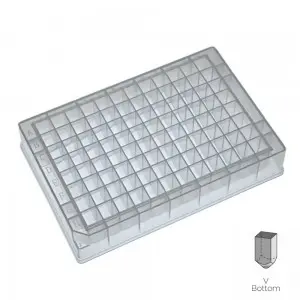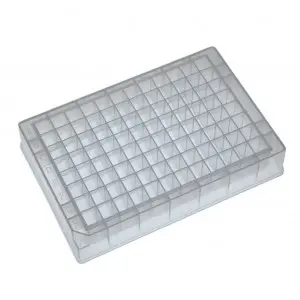96-well deep well plate (Deep Well Plate) is a kind of multi-well plate commonly used in laboratories. It has a deeper hole design and is usually used for experiments that require larger volumes of samples or reagents. The following are some of the main application ranges and usage methods of 96-well deep well plates:
Application range:
High-throughput screening: In experiments such as drug screening and compound library screening, 96-well deep well plates can accommodate more samples and improve experimental efficiency.
Cell culture: Suitable for cell culture experiments that require a larger volume of culture medium, especially the culture of adherent cells.
Enzyme-linked immunosorbent assay (ELISA): Used in ELISA experiments that require a larger volume of reaction system.
Molecular biology experiments: Such as PCR reactions, DNA/RNA extraction, electrophoresis sample preparation, etc.
Protein expression and purification: Used in experiments with large protein expression or requiring a larger volume of buffer.
Long-term sample storage: Due to the larger hole depth, the volume change of the sample during freezing can be reduced, which is suitable for long-term storage.


Usage method:
Sample preparation: According to the needs of the experiment, accurately measure the appropriate amount of sample or reagent and add it to the well of the deep well plate.
Sealing: Use a suitable sealing film or gasket to seal the well plate to prevent sample evaporation or contamination.
Mixing: Gently shake or use a multichannel pipette to mix the sample to ensure that the sample is in full contact with the reagent.
Incubation: Place the deep-well plate in a constant temperature box or other suitable environment for incubation according to the experimental requirements.
Reading data: Use instruments such as microplate readers and fluorescence microscopes to read the experimental results.
Cleaning and disinfection: After the experiment, use appropriate detergents to clean the deep-well plate and disinfect it.
Storage: The deep-well plate should be properly stored after cleaning and disinfection to avoid contamination.
When using 96-well deep-well plates, the following points should also be noted:
Operation specifications: Follow aseptic operation specifications to avoid sample contamination.
Accuracy: Use a multichannel pipette or an automatic liquid handling system to improve the accuracy of the operation.
Clear marking: Make sure that each well of the well plate is clearly marked for easy identification and recording.
96-well deep-well plates are an important tool for high-throughput experiments in the laboratory. Proper use can greatly improve the efficiency and accuracy of the experiment.
Post time: Aug-13-2024

